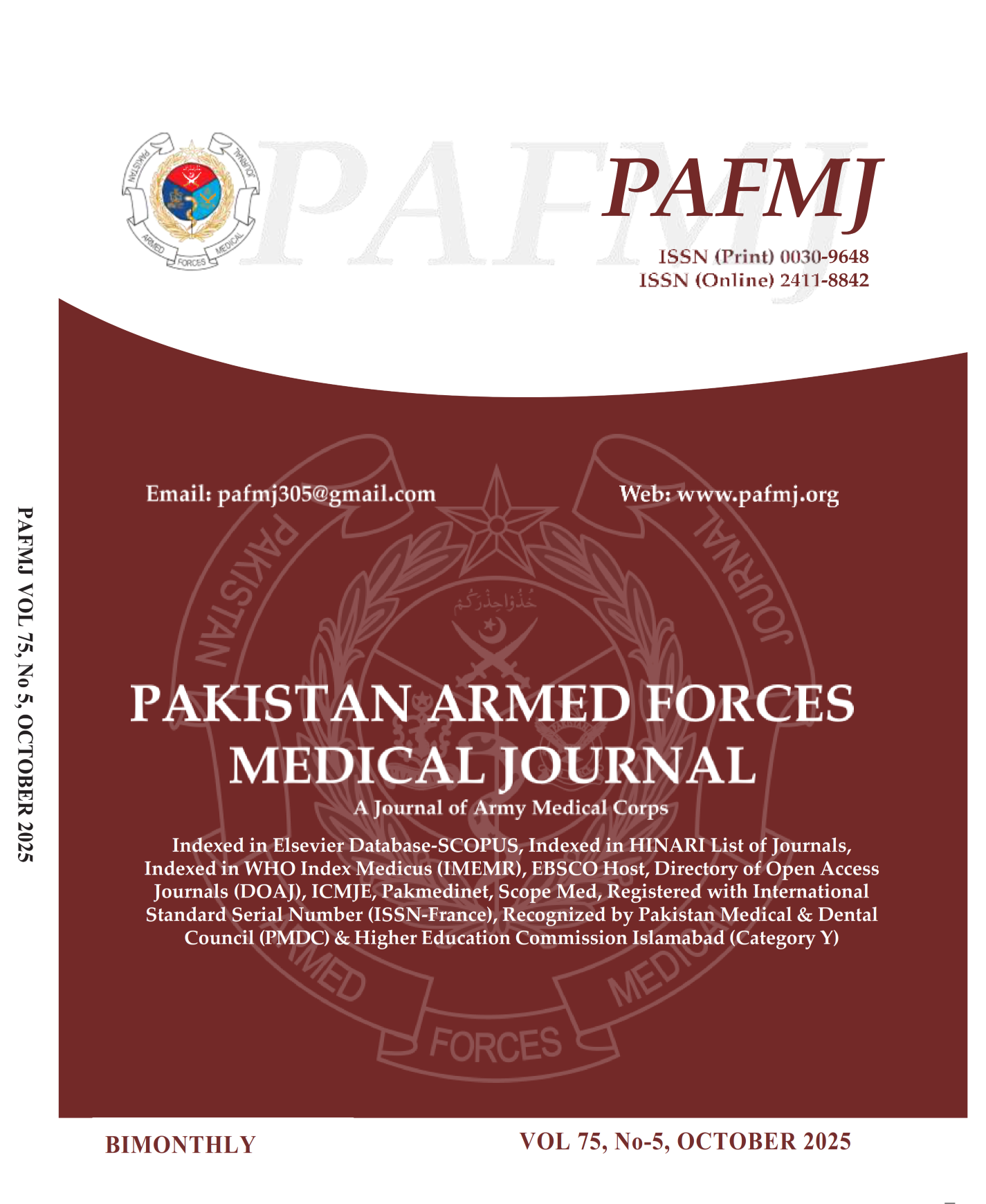Histological Analysis and Comparison of Endometrial Sampling and Hysterectomy Specimen in Patients with Abnormal Uterine Bleeding
DOI:
https://doi.org/10.51253/pafmj.v75i5.10883Keywords:
Abnormal Uterine Bleeding, Endometrioid Carcinoma, Endometrial Hyperplasia, HysterectomyAbstract
Objective: To determine the frequency of different causes of Abnormal Uterine Bleeding (AUB) in relation to the age and to determine the degree of concordance in diagnosis on endometrial sampling and hysterectomy specimen with special emphasis on type and FIGO Grade of malignant cases.
Study Design: Cross- sectional study.
Place and Duration of Study: Histopathology Department, Foundation University Medical College Islamabad Pakistan, from July 2022 to July 2023.
Methodology: A total of 321 cases of endometrial sampling were included in the study. Age of the patients along the histological diagnosis was evaluated. Cases that underwent hysterectomy were further compared with the histological outcome.
Results: We found that in the premenopausal age group, among 253 cases, chronic endometritis 102(40.3%) was the most common finding followed by endometrial hyperplasia 66(26%) and disordered proliferative endometrium 38(15%). In the post-menopausal age, the incidence of malignancy was quite high (n=39), with endometrioid carcinoma being the most frequent diagnosis 24(61.5%), followed by endometrial hyperplasia. We observed maximum concordance in the histological diagnosis of malignancy between endometrial and subsequent hysterectomy samples. Strong agreement was also detected between endometrioid carcinomas Grade 1(97.4%) and Grade 2(100%).
Conclusion: chronic endometritis, endometrial hyperplasia, disordered proliferative endometrium and malignancies are the most common causes of abnormal uterine bleeding. Endometrial sampling emerged as a valuable diagnostic tool, particularly in detecting malignancy.
Downloads
References
1. Rezende GP, Yela Gomes DA, Benetti-Pinto CL. Prevalence of abnormal uterine bleeding in Brazilian women: Association between self-perception and objective parameters. PLoS One 2023; 18(3): 1–10. https://doi.org/10.1371/journal.pone.0282605
2. Munro MG, Critchley HOD, Fraser IS, Haththotuwa R, Kriplani A, Bahamondes L, et al. The two FIGO systems for normal and abnormal uterine bleeding symptoms and classification of causes of abnormal uterine bleeding in the reproductive years: 2018 revisions. Int J Gynaecol Obstet 2018; 143(3): 393–408. https://doi.org/10.1002/ijgo.12666
3. Kazemijaliseh H, Ramezani F, Behboudi-Gandevani S, Khalili D, Hosseinpanah F, Azizi F. A Population-Based Study of the Prevalence of Abnormal Uterine Bleeding and its Related Factors among Iranian Reproductive-Age Women: An Updated Data. Arch Iran Med 2017; 20(9): 558–563.
4. Ansari A, Urooj U. Study of causes behind abnormal uterine bleeding according to PALM- COEIN classification at a tertiary care hospital. J Pak Med Assoc 2020; 70(1): 154–157. https://doi.org/10.5455/JPMA.2749
5. Kitahara Y, Hiraike O, Ishikawa H, Kugu K, Takai Y, Yoshino O, et al. National survey of abnormal uterine bleeding according to the FIGO classification in Japan. J Obstet Gynaecol Res 2023; 49(1): 321–330.
https://doi.org/10.1111/jog.15464
6. Nees LK, Heublein S, Steinmacher S, Juhasz-Böss I, Brucker S, Tempfer CB, et al. Endometrial hyperplasia as a risk factor of endometrial cancer. Arch Gynecol Obstet 2022; 306(2): 407–421. https://doi.org/10.1007/s00404-021-06380-5
7. Sung H, Ferlay J, Siegel RL, Laversanne M, Soerjomataram I, Jemal A, et al. Global Cancer Statistics 2020: GLOBOCAN Estimates of Incidence and Mortality Worldwide for 36 Cancers in 185 Countries. CA Cancer J Clin 2021; 79(3): 209–249. https://doi.org/10.3322/caac.21660
8. Doherty MT, Sanni OB, Coleman HG, Cardwell CR, Glenn McCluggage W, Quinn D, et al. Concurrent and future risk of endometrial cancer in women with endometrial hyperplasia: A systematic review and meta-analysis. PLoS One 2020; 15(4): 1–21.
https://doi.org/10.1371/journal.pone.0232231
9. Raglan O, Kalliala I, Markozannes G, Cividini S, Gunter MJ, Nautiyal J, et al. Risk factors for endometrial cancer: An umbrella review of the literature. Int J Cancer 2019; 145(7): 1719–1730.
https://doi.org/10.1002/ijc.31961
10. Kisielewski F, Gajewska ME, Marczewska MJ, Panek G, Wielgoś M, Kamiński P. Comparison of endometrial biopsy and postoperative hysterectomy specimen findings in patients with atypical endometrial hyperplasia and endometrial cancer. Ginekol Pol 2016; 87(7): 488–942.
https://doi.org/10.5603/GP.2016.0031
11. Ferrari F, Forte S, Arrigoni G, Ardighieri L, Coppola MC, Salinaro F, et al. Impact of endometrial sampling technique and biopsy volume on the diagnostic accuracy of endometrial cancer. Transl Cancer Res 2020; 9(12): 7697–7705. https://doi.org/10.21037/tcr-20-2074
12. Concin N, Matias-Guiu X, Vergote I, Cibula D, Mirza MR, Marnitz S, et al. ESGO/ESTRO/ESP guidelines for the management of patients with endometrial carcinoma. Int J Gynecol Cancer 2021; 31(1): 12–39.
https://doi.org/10.1136/ijgc-2020-002230
13. Soslow RA, Tornos C, Park KJ, Malpica A, Matias-Guiu X, Oliva E, et al. Endometrial Carcinoma Diagnosis: Use of FIGO Grading and Genomic Subcategories in Clinical Practice: Recommendations of the International Society of Gynecological Pathologists. Int J Gynecol Pathol 2019; 38(1): S64–74.
https://doi.org/10.1097/PGP.0000000000000518
14. Vitale SG, Buzzaccarini G, Riemma G, Pacheco LA, DiSpiezio A, Carugno J, et al. Endometrial biopsy: Indications, techniques and recommendations. An evidence-based guideline for clinical practice. J Gynecol Obstet Hum Reprod 2023; 52(6): 102588. https://doi.org/10.1016/j.jogoh.2023.102588
15. Upadhyay A, Tyagi M, Gupta S, Bansal R, Varma Y. Comparative study of hysteroscopy with ultrasonography and its correlation with histopathology in cases of abnormal uterine bleeding in perimenipausal women. Int J Reprod Contraception, Obstet Gynecol 2022; 11(3): 791-798.
https://doi.org/10.18203/2320-1770.ijrcog20220558
16. Dhakhwa R, Bhattarai R, Shah J, Shakya A, Pradhan S. Benign Histopathologic Findings of Endometrium among Perimenopausal Women presenting with Abnormal Uterine Bleeding: A Descriptive Cross-sectional Study. J Nepal Med Assoc 2021; 59(243): 1141–1145.
https://doi.org/10.31729/jnma.7146
17. Mohanlal RD. Endometrial sampling at an academic hospital in South Africa: Histological findings, lessons learnt and interesting surprises. Afr J Lab Med 2020; 9(1): 1–7. https://doi.org/10.4102/ajlm.v9i1.1038
18. Bhat R, Sudhamani S, Roplekar P. Histopathological study of endometrium in abnormal uterine bleeding in perimenopausal and postmenopausal women. J Sci Soc 2019; 46(3): 95. https://doi.org/10.4103/jss.JSS_39_19
19. Nithyananda B, Bheeshma B AF. Histopathological Spectrum Of Endometrial Lesions In Perimenopausal And Postmenopausal Women In Abnormal Uterine Bleeding. Int J Sci Res 2017; 6(7): 272–274. https://doi.org/10.18535/jmscr/v5i8.152
Downloads
Published
Issue
Section
License
Copyright (c) 2025 Rubina Riaz, Tariq Sarfraz, Shahmir Riaz, Saba Aneeqa, Yasmin Wahid, Salma Afzal

This work is licensed under a Creative Commons Attribution-NonCommercial 4.0 International License.















